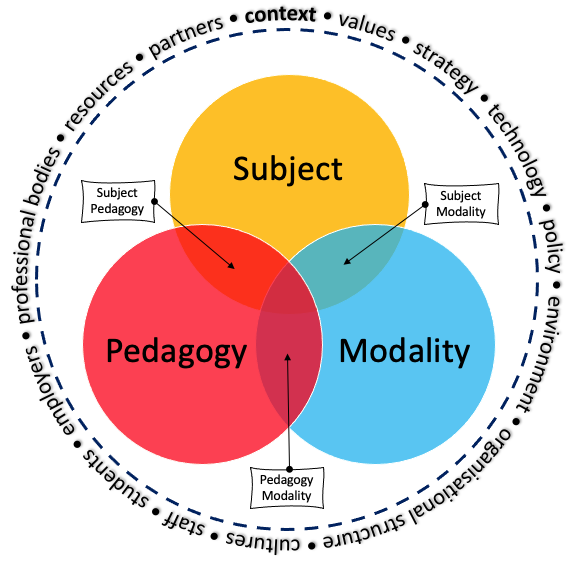Context is everything!
A component of the TPACK framework that is often overlooked is the dashed circular line around the outside of the Venn diagram with the label “contexts” (which has been updated to Contextual Knowledge in this paper by Mishra in 2019).
Notable in its absence across almost all research relating to TPACK (although hinted at in the seminal paper by Koehler & Mishra in 2006) it is arguably one of the biggest influencing factors through which the knowledge areas are both developed and implemented within an educational setting.
In SPaM I have chosen to make these contextual elements more visible to recognise the extent to which they exert influence on local decision making and ultimately end up shaping any learning experience regardless of the ambitions of an individual academic.
In the framework graphic I have included the following, as examples of influencers that defines and shapes the context within which any learning and teaching take places:
- staff
- students
- employers
- professional bodies
- resources
- partners
- values
- strategy
- technology
- policy
- environment
- organisational structure
- cultures
The list is by no means exhaustive – it is merely a representation of the “influences” I have seen first-hand having worked with programme teams and colleagues in developing curriculum. Some of these influences will be unique to institutions, but collectively come together to shape the context within which this framework will operate.
Contexts are important because they can be both enablers and inhibitors. For example you may wish to design a specific online asynchronous activity with a component of peer assessment but your online platform doesn’t have a peer assessment tool to support that. Or you may want to run all of your lectures as online synchronous events but an institutional policy requires that they take place in-person on campus.
Not all context elements are inhibitors. For example an employer relationship might open up opportunities for in-person off campus teaching and online synchronous technology opens up opportunities for having guest lectures join teaching sessions from all over the world.
Some context elements will influence more strongly than others, but it’s important to be mindful of what context you are working within as this will influence aspects of all three domains in some way.

